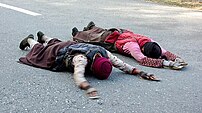 |
If you’ve not heard of the best-selling book Born to Run: A Hidden Tribe, Superathletes, and the Greatest Race the World Has Never Seen you might be want to double check that you are a runner with a network of runners. It seems every runner on the web has written or talked about Born to Run, so why not me?
Well I haven’t really wanted to spend the money and who wants to be part of a fad? That all changed a few weeks ago. We had some time to kill and decided to go to a book store. We were already in Uptown so we checked out Magers & Quinn, a great Minneapolis treasure. I walked out with four books, all purchased below their market price. Born to Run was the only new book, the rest were used.
I was getting bored by the other book I was reading and wasn’t sure if I’d make it through the 282 pages with only 2 weeks left in the month. Well, I was pleasantly surprised that the book was a super-easy read and I finished it with time to spare in March. I was prepared for a book like Bill Bryson’s Walk in the Woods where it was story mixed in with a lot of random facts/rabbit trails/personal issues. McDougall’s is almost all story. Much of what I had heard about the book led me to believe it would be a treatise on barefoot running and a lot of research to back up that perspective.
It is actually pretty late (chapter 25 page 168) in the book before McDougall really starts to present any heavy research and opinions on barefoot running. And it does make you think. For obvious reasons I really liked this quote on pg 201:
Once PF [plantar fasciitis] sinks its fangs into your heels, you’re in danger of being infected for life. Check any running-related message board, and you’re guaranteed to find a bunch of beseeching threads from PF sufferers begging for a cure. Everyone is quick to suggest the same remedies – night splints, elastic socks, ultrasounds, electroshock, cortisone, orthodics – but the messages keep coming because none of them really seems to work.
Isn’t that great! Most of the book is about the Tarahumara Indians in Mexico and how they run for days eating only pinole and wearing thin pieces of rubber (known as Huaraches) and never seem to get hurt. In fact when some of them receive and start wearing running shoes they ended up getting hurt shortly thereafter. The main emphasis of the book is a race held in Mexico in which Scott Jurek, Barefoot Ted, and a few not so famous runners take on the adventure and challenge of a 50 mile trail race against the Tarahumara’s best runners. I won’t tell you the ending! The book spends a lot of time providing the back story for each of the runners and how the Tarahumara became known in the US running world.
McDougall also takes a section of his book to look at the evolution of man and how we evolved into runners. This quote made me laugh (pg 243):
To be fair, our brain knew what it was talking about for 99 percent of our history; sitting around was a luxury, so when you had the chance to rest and recover, you grabbed it. Only recently have we come up with technology to turn lazing around into a way of life; we’ve taken our sinewy, durable, hunter-gather bodies and plunked them into an artificial world of leisure.
![Reblog this post [with Zemanta]](https://i0.wp.com/img.zemanta.com/reblog_e.png?w=625)



